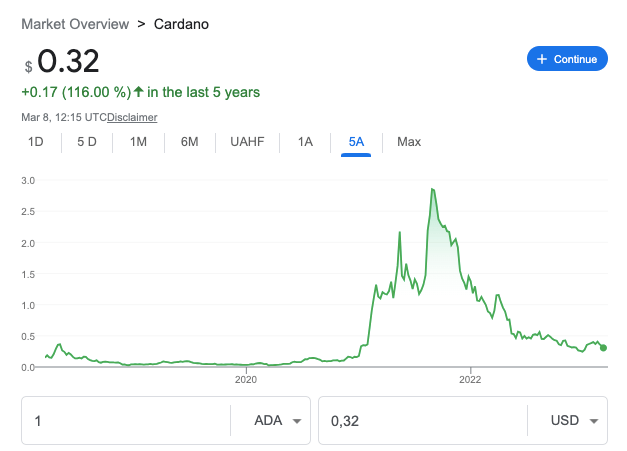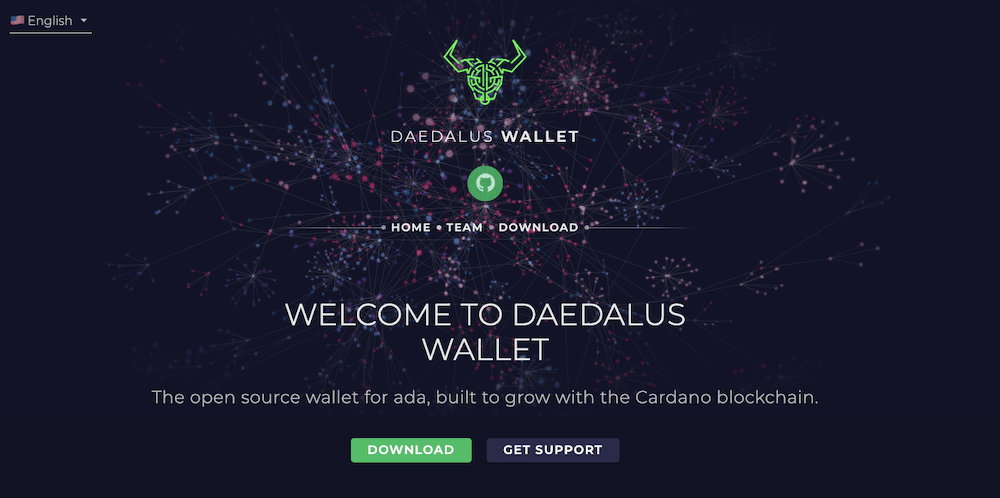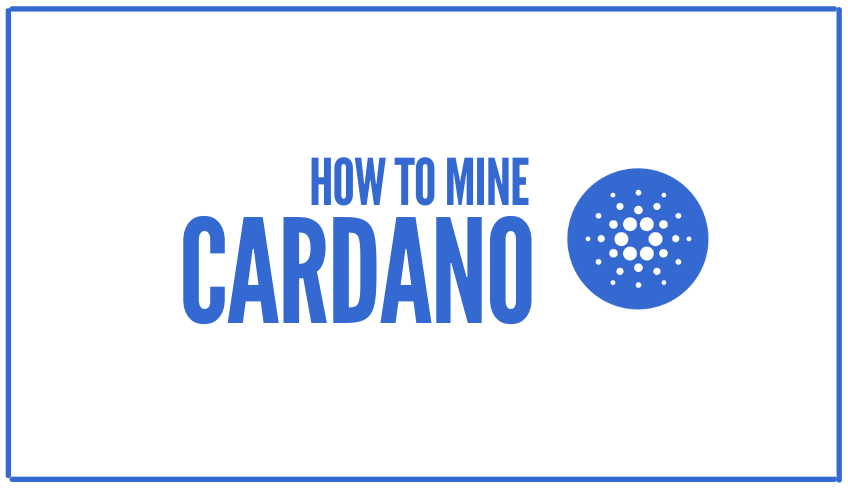If you’re interested in crypto mining and want to try something new, Cardano is one of the best cryptocurrencies to consider. Cardano is a new blockchain platform that uses a proof-of-stake (PoS) consensus mechanism. This method lets you stake your coins and earn rewards without using expensive hardware.
In this blog post, we’ll go over the basics of Cardano mining, including how to set up your wallet, join a mining pool, and start earning rewards.
Table of Contents.
- What is Cardano, and how much is it worth?
- What is Cardano mining?
- How to mine Cardano.
- Example: Staking Cardano with Daedalus wallet
- Final Thoughts.
1. What is Cardano, and how much is it worth?
Have you heard of Cardano? It’s a super cool blockchain platform with the latest tools and technology. It was created by Input Output Hong Kong (IOHK) and founded by Charles Hoskinson, one of the co-founders of Ethereum. The platform was designed to be a more efficient and secure alternative to existing blockchain platforms, such as Bitcoin and Ethereum.
And the best part? It’s the first proof-of-stake blockchain based on peer-reviewed research and built using sound methodologies. Cardano has innovative features that keep your decentralized apps, systems, and society secure and sustainable.
Have you ever wondered how many ADA (Cardano’s native cryptocurrency) coins are out there and what they’re worth? The maximum number of ADA coins that can be mined today is 45 billion. Right now, only 33 billion are in circulation. As for its worth, the value of ADA can fluctuate frequently based on market conditions and investor sentiment. As of March 8, 2023, the value of ADA is around $0.32 per token. Unfortunately, Cardano’s price, along with other cryptocurrencies, has dropped significantly since Sept 2021.

2. What is Cardano Mining?
Before we dive into the process of mining Cardano, let’s first understand what exactly Cardano mining is.
In cryptocurrency, mining allows you to create new coins by verifying transactions and adding them to the blockchain. In the case of Cardano, mining is achieved through staking. Cardano staking involves holding and locking up your coins in a wallet to support the network and earn rewards.
Cardano is designed to support smart contracts, decentralized applications (dApps), and digital asset transfers. All these are essential components of the emerging web 3.0 ecosystem. In addition, Cardano’s blockchain is perfect for hosting dApps and digital assets in the metaverse. Cardano’s tech could play a key role in facilitating transactions in the Metaverse. It could also help in creating virtual economies and enabling interoperability between metaverse platforms.
Some benefits of Cardano (Mining) staking?
With Cardano, you don’t have to worry about traditional mining methods — there’s no need for cloud, GPU, or CPU mining. You can save money on all that equipment, cooling, and electricity and instead invest in ADA— Cardano’s native cryptocurrency.
Cardano uses a Proof-of-Stake protocol to validate transactions. So instead of mining, which creates new coins using hardware, you can “stake” your ADA in a supported wallet or exchange. This “staking” allows you to earn a percentage of ADA as a reward for helping to confirm Cardano transactions. If you’re interested in staking your ADA, check out some of the top Cardano wallets to keep your coins safe (more on this in the next section).
3. How to mine Cardano.
To start mining Cardano, you’ll need a few things: a Cardano wallet, some coins to stake, and access to a mining pool. Let’s break down each of these components in more detail.
Step 1: Obtaining a wallet and a public address.
The first thing you’ll need to do is create a Cardano wallet to store your coins. Obtain a wallet and a public address for the coin you wish to mine and receive funds from the blockchain. The most popular Cardano wallets for staking ADA available are Yoroi, AdaLite, and Daedalus. To start with a wallet, download it and follow the instructions. Once your wallet is set up, you’ll be given a unique “public” address that you can use to receive and send Cardano coins.
Step 2: Create a strong password
When you create a wallet, you’ll also get a password for spending. The spending password grants permission for ADA transactions, delegation to a stake pool, and voting. Use a solid and lengthy password with uppercase and lowercase letters, digits, and special characters. We recommend you write it down and save it in a secure location.
Step 3: Generate a recovery phrase
As with any other cryptocurrency wallet, you must also generate a recovery phrase that you can use to restore your wallet on a separate device. For example, the recovery step for the Yoroi wallet is a 15-word password generated at random. This seed phrase could be used to restore your wallet even without the spending password.
Step 4: Buy and Stake Cardano Coins
Once you set up your wallet, you can buy some Cardano coins to stake. You can buy Cardano from major cryptocurrency exchanges like Binance, Coinbase, and Kraken. Once you’ve bought your coins, you can transfer them to your wallet using the provided address.
Step 5: Joining a Mining Pool
We recommend joining a Cardano mining pool to increase your chances of earning rewards. Mining pools are groups of miners who combine their computing power to increase their chances of successfully mining a block and earning rewards. Several mining pools are available for Cardano, including Cardano PoolTool, AdaPools, and Pool.pm.
Joining a mining pool is simple. All you need to do is create an account and follow the instructions. Once you’ve entered a pool, you’ll need to configure your wallet to point to the pool’s server so that your staked coins are used for mining.
Step 6. Start Mining and Earning Rewards
Now that you’ve set up your wallet and joined a mining pool, you can start staking your Cardano coins and earning rewards. The process is simple:
- Leave your wallet open and connected to the internet.
- Your staked coins will be used to validate transactions and create new blocks on the blockchain.
- The rewards you earn will depend on several factors, including the number of coins you stake, the size of the mining pool, and the overall network difficulty.
- You will get your rewards in Cardano coins automatically sent to your wallet.
4. Example of staking Cardano using Daedalus wallet
The Daedalus wallet is a full-node wallet. It will download the whole Cardano blockchain onto your computer, which is a secure approach to avoid network troubles caused by third parties (such as ISPs, governments, etc.).

- Step 1: If you don’t already have one or want to stake ADA using a different wallet, create a new wallet after downloading and installing Daedalus on your computer. Always use a secure location to store your seed passphrase.
- Step 2: Once you launch the Daedalus wallet, navigate to “Delegation Center” and click the “Stake pools” link at the very top.
- Step 3: Now, locate an ADA betting pool. If you know the pool’s name, you can search for it.
- Step 4: After selecting a stake pool, users could decide how much ADA to delegate to that stake pool.
- Step 5: Before delegating the ADA to a pool, you can view additional information about it by clicking on its name.
- Choosing an unsaturated pool so that you can maximize your earnings is essential. You must pay a little extra if you opt to delegate ADA to a staking pool.
5. Final Thoughts
Cardano is a promising new cryptocurrency that offers a more energy-efficient and eco-friendly alternative to traditional proof-of-work cryptocurrencies like Bitcoin and Ethereum. By staking your coins and joining a mining pool, you can help support the network and earn rewards.
We hope this guide has helped you understand how to start Cardano mining. If you have any questions or comments, please leave them below.


